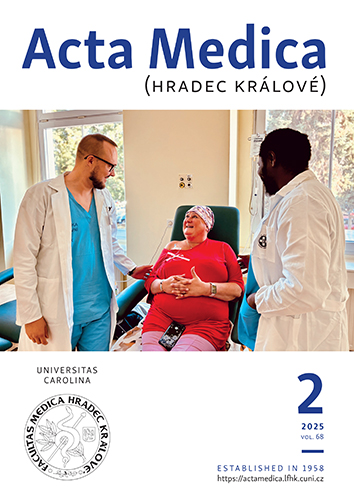ACTA MEDICA, Vol 62 No 2 (2019), 62–68
Dependence of Deciduous Tooth Eruption Terms and Tooth Growth Rate on the Weight-Height Index at Birth in Macrosomic Children over the First Year of Life
Olga Garmash
DOI: https://doi.org/10.14712/18059694.2019.48
zveřejněno: 26. 07. 2019
Abstract
The aim of this research is to study the effect of body overweight at birth (fetal macrosomia) on the processes of tooth eruption and tooth growth during the first year of life in children in the Kharkiv City (Ukraine) population. One of the research tasks is to examine the features of deciduous teeth eruption in children who were born with macrosomia with different values of the weight-height index at birth. Materials and methods. The medical records of the children born between 1977 and 2013 have been analyzed. The database has been collected in one of the Kharkiv City clinic. The Main Group is comprised of the medical records of the children (separately for boys and girls) born with fetal macrosomia. All the medical records of the Main Group have been divided into subgroups taking into account the gender and the harmonious (well-balanced) development coefficient. The Comparison Group is comprised of the medical records of the children also born within the normal term range, but with weight and height that correspond to the gestation age (fetal normosomia). To determine the average time of the first tooth eruption, as well as the deciduous teeth growth rate for each of the groups under the study, we have used the hypothesis about a linear dependence between the number of erupted teeth and the age of the child. The statistical data processing and verification of the consistency of this hypothesis is performed using the multiple linear regression analysis with the STATISTICA 6.0 software package (Multiple Regression module). The number of delayed eruption and premature eruption cases observed is calculated along with the corresponding confidence intervals for the significance level, p, of less than 0.05, taking into account the binomial distribution of the random variable. The results of the study indicate a slowed growth rate of deciduous teeth in children born with macrosomia, as well as an increased number of cases (by a factor of 2 to 4 times) of deviations in the timing of teeth eruption compared to regional norms. The smallest growth rate of deciduous teeth and the smallest number of teeth at the age of one year are registered in macrosomic boys and macrosomic girls with a long body and a relatively reduced birth weight, as well as in macrosomic girls with intrauterine obesity. The macrosomic girls with intrauterine acceleration with obesity at the background have the largest average tooth growth rate and the largest percentage of premature eruption cases among all subgroups. Conclusions. The somatometric features of fetal macrosomia suggest the influence on the number of teeth that erupt by a certain age. The data on the deviation from the generally accepted terms of teeth eruption in children born with macrosomia, can be the basis for developing new and improving existing prevention programs aimed at preserving dental health.
klíčová slova: fetal macrosomia; height-weight index; deciduous teeth

Dependence of Deciduous Tooth Eruption Terms and Tooth Growth Rate on the Weight-Height Index at Birth in Macrosomic Children over the First Year of Life is licensed under a Creative Commons Attribution 4.0 International License.
210 x 297 mm
vychází: 4 x ročně
cena tištěného čísla: 150 Kč
ISSN: 1211-4286
E-ISSN: 1805-9694
